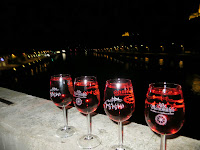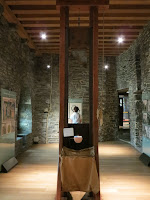We anticipated long lines but it was early in the morning and we only had to wait at the outside gate for a few minutes before passing through to the next checkpoint. We had to surrender all of our bags and the contents of our pockets. Absolutely no cell phones or any type of camera are allowed inside the mausoleum. We went through another set of metal detectors leading into the area around the tomb. Some people were patted down by armed police or military guards.
The first thing you see are a long line of tombs, Stalin's included. His bust tops a pillar rising up from the ground. His is accompanied by the busts of other important Russians. I confess I didn't recognize many of the names. We passed through the stone graveyard respectfully and wound our way around the granite structure housing the tomb. Several wide steps lead to the entrance where a young military guard stands erect. As we entered, he kept his eyes forward and gestured our next steps with his right hand lifted toward a long hallway. It took a moment for my eyes to adjust to the darkness of the tomb, even though it was a very overcast day. The interior was eerily illuminated with soft, red lighting. At the end of the hallway stood another guard. This time it was his left hand we followed as we rounded the corner. This corridor was shorter and we met with one final guard who stood at the entrance to Lenin's tomb.
 |
| Lenin's Tomb |
I'm not sure how to describe this moment. First, it was extremely quick. We walked around the tomb, joined by a couple of Asian tourists. Since it was just us, the setting was extremely intimate and I almost felt as if I was somehow intruding. For a man who's been on display since 1924, I'd say Lenin is in pretty good shape. It looks like his hands may have shrunk over time and, to be expected, the appearance of his body is very waxy and mannequin-like. He looks to be in peaceful repose, with his hands neatly touching at his waist, his tidy mustache and beard giving a sense that, at any moment, he will open his eyes, sit up, and ask what he's doing in this crypt.
We took a quick lap around the tomb and then made our way out, guided once again by the guards. It all happened so fast. I think the amount of time, from the moment we left our belongings at the lockers and went through security, to the second we emerged at the gates, took a total of 10-12 minutes. It was certainly surreal. So many thoughts went through my mind. I was impressed by how heavily and respectfully guarded it was, how regal Lenin looks, and then after these thoughts some immaturity surfaced as I shuddered and said to my husband, "Oh my God!! A dead body! We just saw a dead body!!!"
After I made this astute observation, I took a photo of my husband in front of the tomb (outside of the gates). As I pulled the camera away from my eyes, I noticed two old women who I assume were mother and daughter. The mother looked like she was in her nineties and her daughter seemed to be about twenty years younger. They had just emerged from the tomb and were holding onto each other, crying softly and wiping tears from their eyes. In that moment I remembered that a visit to Lenin's tomb is much more than a thing to cross of a "To-Do" list for some. Obviously these were Russian women who came to solemnly pay their respects to Lenin. Who knows what they've experienced in their long lives, during the past ninety years of Russian history? Whatever it has been, they wanted to visit Lenin and weep over his earthly remains.
I was sobered by their tears. There wasn't really too much left to say after the whole experience so we did the only thing you can do when you feel too sober; we found a bar.
Che is a bar and restaurant named in honor of Che Guevara. We located it quickly and were greeted by a distinguished man in a dark grey suit. When we spoke English, he looked very taken aback and a female hostess emerged, recovering for him. As we followed her into the dining room, I glanced back and saw him still standing in the doorway, motionless, with his arms half-raised.
In general, in restaurants and cafes, at least one person spoke English. Most of the time it was halting but they seemed genuinely curious about us. We were asked many times, by incredulous people, "Where do you come from?" Sometimes it wasn't immediately clear to them that we were American. They thought we were British or Australian so it was even more shocking to them when we replied, "Chicago and Florida."
We were given menus (in Cyrillic) so we just ordered two beers. We think they were Russian beers but we can't be sure. They were brought to us hastily, large steins filled with frothy deliciousness. We were the only patrons for a while. The staff gathered at the bar at one point and stole clandestine looks at us. It was apparent that they were curious and amused. I wanted to explain, "We're having beers at 11am because we just saw Lenin! His dead body!" But I didn't really know if this would go over very well. Eventually a businessman joined us in the restaurant. He was immaculately-dressed and was promptly served soup and bread. He ate his food methodically while watching a Discovery Channel show dubbed in Russian, projected on a big screen at the head of the bar.
 |
| Tomb of the Unknown Soldier |
 |
| Eternal Flame |
 |
| Changing of the Guard |
Next, we strolled through the Bolshoi District which wasn't quite what we expected. Walking through the streets was interesting. There were throngs of people but it was very quiet. The people we passed didn't betray any emotions, their eyes gazed forward as they purposefully strode toward their destinations. Another thing that makes walking through Moscow interesting is the amount of armed guards. Sentries casually brandishing machine guns stood outside innocuous-looking buildings frequently. It was quite shocking to suddenly come upon street barricades and military police but it happened often. Of course the Muscovites took no notice of the security because they are accustomed to it and probably comforted by it.
 |
| Delicatessen Restaurant |
It was a bustling place on a cold October afternoon. We passed the beautiful antique bar and were seated at a wooden table in the back portion of the restaurant. A waitress came to take our drink order and asked simply if we would like hot or cold. We chose cold and were brought two glasses of fruit juice. She then returned for our food order and asked if we would like lunch or the menu. We were a little confused so we replied, "Lunch?" She swiftly walked away and returned a few minutes later with bowls of steaming homemade chicken noodle soup paired with soft, chewy bread. The bowls were cleared away as soon as we slurped the last bits of soup from them. The next course was some type of rice with seafood, almost like a paella. Finally, we were served a dessert that resembled a pound cake in texture and taste, with little bits of candied apricot baked throughout. We decided to finish with some vodka (we were in Russia, after all), and we were in luck because Delicatessen serves some interesting infused vodkas. I chose cherry-flavored while my husband went with pine nut.
The walk back to our hotel was also long and cold. We put up our feet for a while before we made our way back out into the frigid evening for dinner. We were looking for a particular restaurant and after searching for several minutes on the correct street, we finally realized that our intended destination had been replaced by another dining establishment, The Blue Cat. We didn't have anywhere else in mind so we decided to settle there for the evening. It turned out to be a very good choice.
The atmosphere inside was bright and intimate. Only two other couples joined us as we dined decadently on fish, steak, and rabbit. The French wine was excellent and the service was great. My husband's dessert was the piece-de-resistance- a chocolate lava cake bursting with a bleu cheese concoction, a dish he describes as "insanely good."
Dining at The Blue Cat was one of those happy cases where you didn't find quite what you were looking for, but you're pleasantly surprised and extremely satisfied by the place you ended up anyway.
Next on the agenda is our grand tour of the Kremlin. It was a fun and informative way to spend our final day in Moscow, especially since a visiting royal from another county made a surprise appearance!
Until next time, spasiba for reading!
 |
| Lenin's Tomb at Night |















































